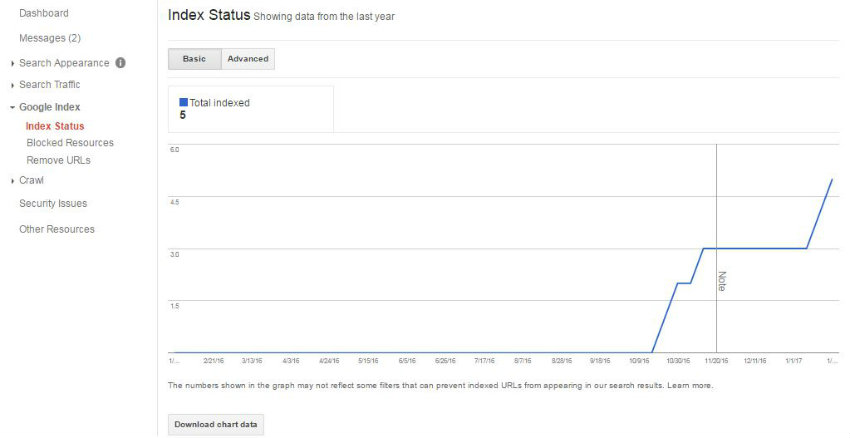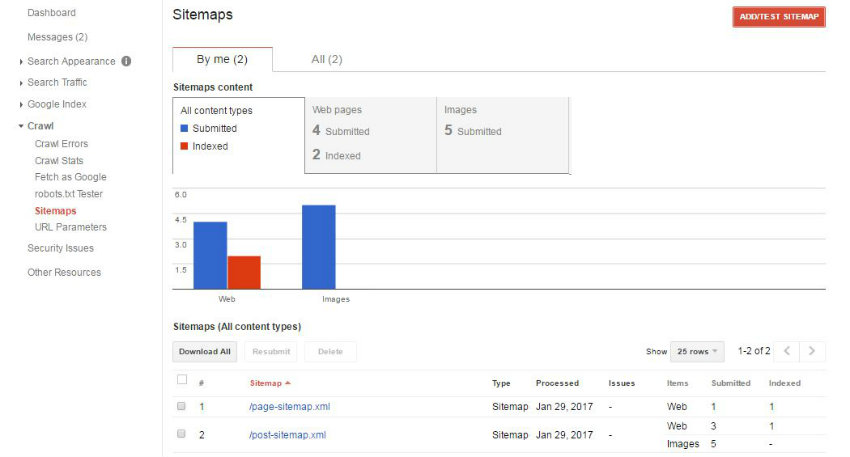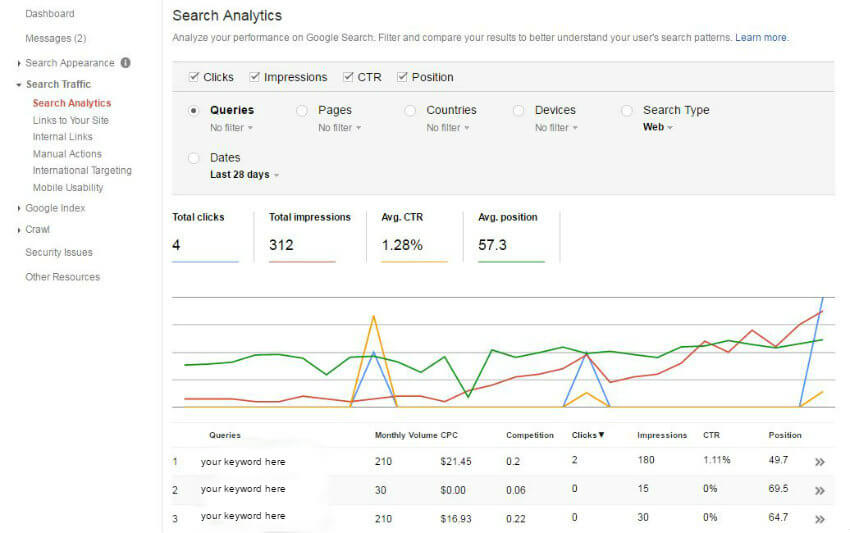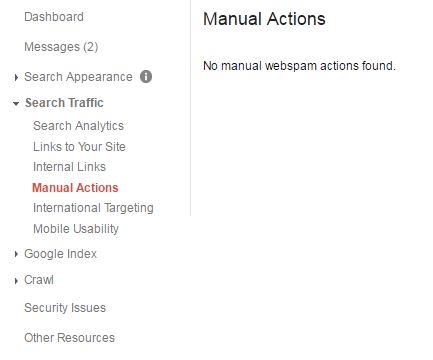This can be a frustrating time for a small business. Don’t hesitate to turn to a Cleveland SEO agency if you don’t want to invest your own time. It’s estimated that Google receives over two trillion searches per year. That presents a huge opportunity for your business to be found, and that’s not even counting searches from Bing or Yahoo.
But, back to your question: why is my website not on Google?
Let’s start by figuring out whether your site isn’t being indexed by Google at all, or if you just can’t find your site by searching some keywords that you’d expect to see your site rank for. It could just be that you need to learn how to check website ranking in Google Search.
Is my website indexed on Google?
It could be that when you ask, “Why doesn’t my website show up in Google Search?” you really want to know if it’s indexed at all. Further, if it isn’t indexed, how do you get it indexed?
There are two tricks you can use to figure out whether or not your website is indexed at all.
Advanced search operators
The first method involves using advanced search operators in your Google search. Ironically, Google’s own documentation on the subject isn’t nearly as good as this guide in the link above.
The search operator we’re most interested in is the site: operator. By appending your domain name and extension to the site: operator, you can search any page on your site that Google currently has in its index.
For example, by entering site:searchenginecoach.com into the search bar and hitting enter, you can search every page on the Search Engine Coach website.
Do the same for your site to see which pages (if any), Google currently holds in its giant database of web pages. If nothing shows up, that’s pretty clear evidence that you have some issues to take care of. The second part of this article, How Do I Get My Website Listed on Google, will make sure you’re on the board so you can start reaching your target audience organically.
Google Search Console
The second trick for a website not on Google is to check Google Search Console. You’ll hear me say time and again that this is the most useful tool for SEO that exists – especially when you’re just starting to learn how to SEO a website. It’s basically a peek into the minds of your target audience, and the diary that Google keeps about your website.
If you don’t have Search Console set up, you’ll want to do that now. It will take a couple of days for the data in some of the reports to start showing up, so the sooner you can verify your Search Console account, the better. I have an article about how to do this in the works, so stay tuned.
If you have Search Console set up, you’ll want to take a look at two different reports.
- The Index Status report
- The Sitemaps report
Index Status
You can get to the first report from the side menu by clicking Google Index > Index Status. The blue line in the basic Index Status report will indicate how many of your pages are indexed by Google. If all you see is a flat, blue line, this means that none of your pages are being indexed by Google. Jump to the second section of this article to figure out how to fix that.

Sitemaps
The second report that you can take a look at is the sitemaps report. You can get to this from the left side nav by clicking Crawl > Sitemaps. If you haven’t added any sitemaps to Search Console, you won’t see anything on this page. Not to worry, setting a sitemap up is easy if your website is hosted on WordPress.
Go to the WordPress plugin directory, and search for a “sitemap generator.” You’ll see a number of different plugins that you can install and activate that will generate your sitemap. The plugin will usually tell you the URL of your sitemap. Simply copy your sitemap URL, and you’re ready to add it to Search Console. I use the Yoast SEO plugin on my site. This plugins has a TON of useful features, and auto-generating sitemaps is one of them.
To submit your sitemap to Search Console, navigate back to the Crawl > Sitemaps page and click the red “Add/Test Sitemap” button in the top right corner. Enter the last part of your sitemap URL (exclude your domain, extension, and the trailing slash – Search Console already knows what it is), click submit, and then refresh the page.

The blue bars will display how many pages and images have been submitted to Google from your sitemap, and the red bars will show how many pages and images have been indexed. If you’re not seeing any red, your site is invisible to Google, and you’ll want to pay attention to the section about getting your site indexed.
Are you accidentally blocking your own site?
If your site isn’t showing up in any organic searches, there could be an embarrassingly easy solution. You’ll want to take a look at your Robots.txt to see if you’re not giving permission for search engines to crawl your site.
There’s a good chance you’ve never heard of your Robots.txt file before, but don’t worry, it’s easy to find. Go to your homepage, and add robots.txt to the end of the URL. For example, if your site is located at https://www.example.com/, your robots file will be at https://www.example.com/robots.txt.
For a lot of WordPress sites, the robots.txt will look something like this:
User-agent: *
Disallow: /wp-admin/
Allow: /wp-admin/admin-ajax.php
User Agent
Basically, the User-agent part is specifying which robot you’re giving directions to. The * indicates that you’re talking to all robots. Or you could get specific, and use something like “User-agent: Googlebot” to indicate that you are giving directions specifically for Google’s web crawler.
Disallow
This section lets you list any directories that you want to prevent from being crawled by the robots you specified in the User-agent section. So in the WordPress example above, we are disallowing the /wp-admin/ folder, and any of its subfolders.
Another example would be using “Disallow: /” which would then block every single folder on your site, and only your homepage would be crawled and indexed.
It’s important to remember that disallowing a folder will also block any sub-folders. You may need to make a specific subfolder available to robots so they can fully understand your site.
Allow
The allow instruction is something that only Googlebot understands. Other bots may not recognize this as a valid instruction. The allow part of your robots file indicates that it is actually alright for Google to crawl a folder that you had previously disallowed.
Let’s use an analogy for our example. Imagine you want to tell Google, “I hate every character on Friends, except for Rachel.” Your robots.txt would say:
User-agent: *
Disallow: /friends/
Allow: /friends/rachel/
Googlebot would then be able to tell that you have good taste, and might even give you a rankings boost because of it (not true, bad joke).
So as a robots.txt wrap up, if your robots file looks like the following, you have figured out why your site isn’t being indexed.
User-agent: *
Disallow: /
You’ll want to change your robots file to:
User-agent: *
Disallow:
Read through and try Google’s own Robots.txt tester to see what Google thinks of your robots instructions.
How do I Get my website listed on Google?
You’ve made it to this section for one of two reasons. Your site is either not being indexed by Google, or it is, but it’s so deep in the search results that you could hide a dead body within your pages and no one would ever find it.
Are you ranking for anything at all?
You can check to see if you rank for any user queries with Google Search Console. From the left side menu, click on Search Traffic > Search Analytics. This will take you to a report that lists all of the recognized user queries for which your site can be found in the search results.

There are a lot of filters and options for this report, so feel free to play around with them. I like to click all of the checkboxes at the very top of the report so that I can see Clicks, Impressions, CTR (click-through rate), and Position.
You might find out that you rank very poorly for every user query that Google keeps track of. For someone to find your site, they could have to click through the first 10 pages. Clicking through 10 pages of search results is a pain in the ass, and no one will actually do this (except for bots).
The above scenario would explain why you asked, “Why is my website not showing in Google Search?” in the first place.
If you don’t see ANY data in this report, you might not be ranking for anything at all. Admittedly, Search Console isn’t perfect. Just to be safe, let’s make sure your website doesn’t have a Google penalty in place.
Make sure Google hasn’t taken manual webspam action against your site
If your site is new, there’s a slim chance of having a manual action in place. However, if you have an older site, and recently noticed that your organic traffic has taken a nose dive, this could be a real concern.
Go to Search Console and navigate to Search Traffic > Manual Actions in the left side menu. If you don’t have any manual webspam concerns, your report should look like the one below.

If Google has noticed suspicious or manipulative search engine optimization tactics on your site, you might not be so lucky. In this case, you’ll need to contact Google’s webspam team to see how you can take care of the issue and start ranking again.
If you haven’t engaged in any manipulative SEO practices, and you’re seeing a webspam penalty, you may have been the target of a negative SEO attack. Follow Google’s instructions to see how you can get your site back on the map.
Do some link-building for your site
Don’t make Google work to find your site! Create plenty of avenues for search engines to run into your site by building backlinks.
Some of the easiest, and most effective methods of building backlinks include:
- Creating social media accounts and listing your site in the bio and/or about sections (won’t directly help rankings)
- Adding your site to relevant directories (could help rankings a bit if follow links are used)
- Having your connections in the internet community mention your site’s creation and link to one of your pages (could help rankings a bit if follow links are used)
- Putting out a press release for your website’s grand opening (won’t directly help rankings)
Googlebot is crawling the internet non-stop at an incredibly fast rate. By leveraging Google’s familiarity with other established sites, and linking to your own, you’re creating pathways for search engines to find you and add your site to their indices.
As always, if you have any questions, comments, or concerns, please leave them in the comments below to get this party started! Your question could end up helping other readers.

